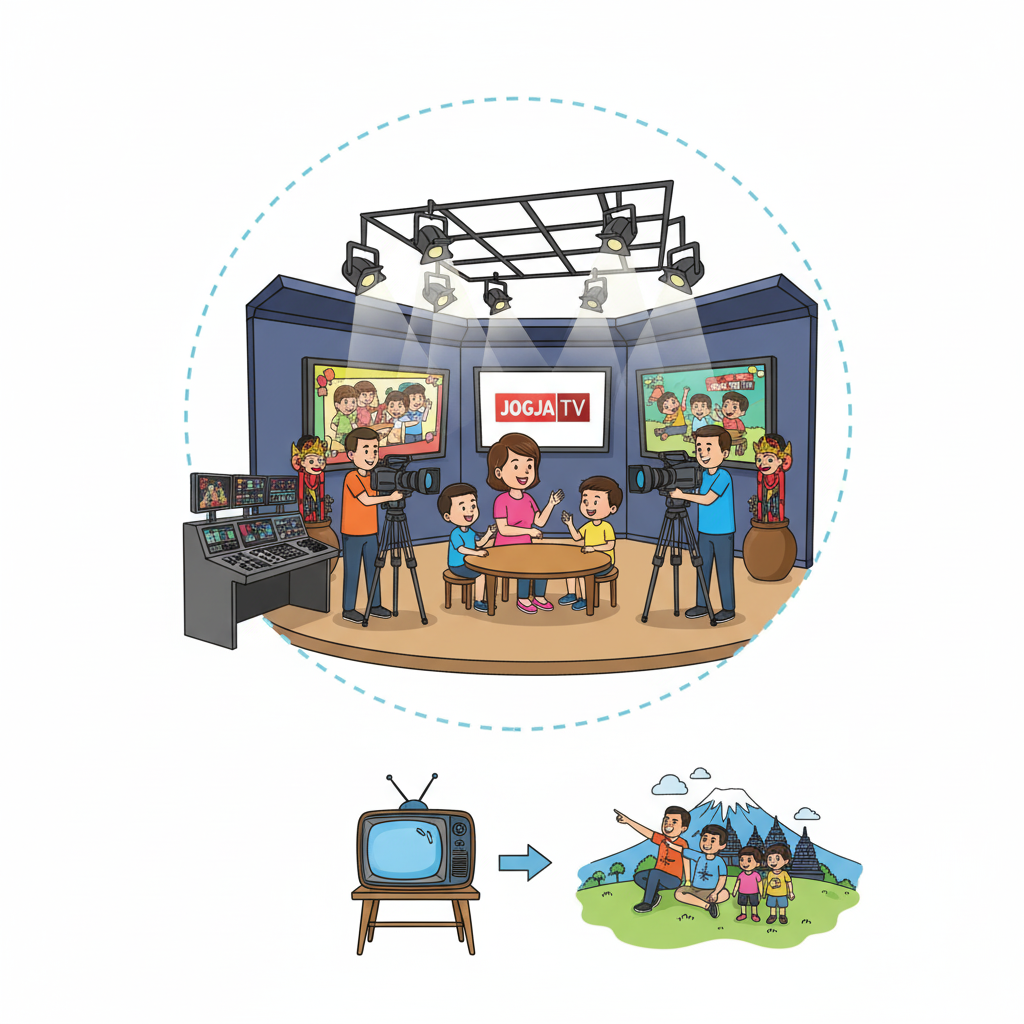Analisis Pengemasan Produksi Konten Lokal pada Program “Ceria Anak” Sebagai Upaya Mempertahankan Eksistensi Program di Stasiun Jogja TV
DOI:
https://doi.org/10.53088/librarium.v2i2.1941Keywords:
Local Content Packaging, Production, Program Existence, TV StationAbstract
This study aims to analyze how the packaging of local content production in the "Ceria Anak" program is an effort to maintain the existence of the program on Jogja TV Station. This type of research is a case study and is descriptive qualitative. Data sources in this study include primary and secondary sources. Primary sources are the results of interviews with program producers, cameramen, and the master control section. Secondary sources are previous research, books, journals, websites, and other references. This data collection was carried out by conducting interviews, observations, and documentation. The results of the study indicate that through the packaging of local content with a structured production process, including pre-production, production, and post-production stages, it is able to maintain the existence of the program on Jogja TV station, especially through the "Ceria Anak" program. This program has succeeded in attracting the attention of children and has become important in children's television in Indonesia. The pre-production stage ensures efficiency, while the production process involves team coordination to produce quality content. Creative strategies and collaboration with art studios are used to present educational and interesting shows. After production, the post-production stage improves the quality of the broadcast before being uploaded to YouTube. This program also functions as a medium for education and cultural preservation, with content that integrates local cultural elements. Management is carried out systematically, and screenings in public locations expand the audience reach.
References
Asih, H. M., & Fitriani, S. (2018). Penyusunan Standard Operating Procedure (SOP) Produksi Produk Inovasi Ecobrick. Jurnal Ilmiah Teknik Industri, 17.
Handayani, C. (2024). Pengaruh Host Dan Pengemasan Program Terhadap Minat Nonton: Studi Kasus Dedy Mahendra Desta Sebagai Host Dan Pengemasan Program Net Tv Terhadap Minat Nonton “Tonight Show.” 2(1).
Jirestiany, E., & Muhsin, H. (2022). Analisis Srategi Manajemen Kresna TV Dalam Upaya Mempertahankan Eksistensi Program Acara Konten Lokal. Jurnal Komunikasi Pemberdayaan, 1(1), 1–9. https://doi.org/10.47431/jkp.v1i1.163
Juditha, C. (2018). Televisi Lokal Dan Konten Kearifan Lokal ( Studi Kasus Di Sindo TV Kendari ). Jurnal PIKOM (Penelitian Komunikasi dan Pembangunan), 16(1), 49. https://doi.org/10.31346/jpikom.v16i1.1337
Khusna, I. A. (2018). Strategi Kreatif Produser Dalam Mempertahankan Eksistensi Program Kangen Tembang-Tembung Di ADITV Yogyakarta.
Kriyantono, R. (2014). Teknik Praktis Riset Komunikasi (Pertama 2006). Kencana Prenadamedia Group.
Kumara, D., Kasmad, K., & Dimiyati, A. (2023). Mengemas Content Marketing Untuk Produk Lokal Dalam Era Digital di Desa Ciampea Udik. Dedikasi PKM, 4(1), 111. https://doi.org/10.32493/dedikasipkm.v4i1.27606
Maulani, N. (2023). Skripsi Tugas-Tugas Sekretaris Di Unit Airport Equipment Pada PT Angkasa Pura I Bandar Udara Internasional I Gusti Ngurah Rai Bali.
Rahayu, T. Y., & Dewi Katili, K. R. (2019). Strategi Program Radio Dalam Mempertahankan Eksistensinya. Makna: Jurnal Kajian Komunikasi, Bahasa, dan Budaya, 4(1), 139–153. https://doi.org/10.33558/makna.v4i1.1677
Santiari, L., Ramayasa, I. P., Suwastika, I. Efendi, E. (2023). Teori Agenda Setting. 7.
Furqany, S. (2018). Manajemen Program Siaran Lokal Aceh Tv Dalam Upaya Penyebarluasan Syariat Islam dan Pelestarian Budaya Lokal. SOURCE : Jurnal Ilmu Komunikasi, 2(2). https://doi.org/10.35308/source.v2i2.391
Haryati. (2013). Eksistensi Media Lokal Di Era Konvergensi. Balai Pengkajian Dan Pengembangan Komunikasi Dan Informatika Bandung, 11.
Imroni Yusuf, M. (2022). Eksistensi Televisi Lokal Di Tengah Era Konvergensi Media Digital (Studi kasus pada pengelolaan konten siaran dan SDM di Jawa Timur Televisi (JTV) Jember. [Undergraduate, Universitas Islam Negeri Kiai Haji Achmad Siddiq Jember]. https://digilib.uinkhas.ac.id/12184/?utm_source=chatgpt.com
Karunia H, H., Ashri, N., & Irwansyah, I. (2021). Fenomena Penggunaan Media Sosial: Studi Pada Teori Uses and Gratification. Jurnal Teknologi Dan Sistem Informasi Bisnis, 3(1), 92–104. https://doi.org/10.47233/jteksis.v3i1.187
Saputro, Deny Prio, & Gilang Gusti Aji. (2018). Eksistensi TV Lokal dan Pelestarian Budaya. 1. https://doi.org/10.26740/tc.v1i2.26949
Susanti, S., & Ratmita, R. A. (2020). Manajemen Produksi Program Berita Di inews Tv Bandung. 2.
Wakas, J. E., & Wulage, M. B. N. (2008). Analisis Teori Uses And Gratification: Motif Menonton Konten Pada Media Sosial Tiktok.
. K., Jepriana, I. W., & Rahayuda, I. G. S. (2024). Pengemasan dan Peningkatan Desain Kemasan Produk Industri Rumah Tangga Nyoman Restini. Widyabhakti Jurnal Ilmiah Populer, 6(2), 41–46. https://doi.org/10.30864/widyabhakti.v6i2.405
Septi, V. (2021). Tindak Tutur Ilokusi Dan Perlokusi Pada Tuturan Pujian Di Media Sosial Youtube. repository.upi.edu , perpustakaan.upi.edu
Septiani, Y., Aribbe, E., & Diansyah, R. (2020). Analisis Kualitas Layanan Sistem Informasi Akademik Universitas Abdurrab Terhadap Kepuasan Pengguna Menggunakan Metode Sevqual (Studi Kasus: Mahasiswa Universitas Abdurrab Pekanbaru). Jurnal Teknologi Dan Open Source, 3(1), 131–143. https://doi.org/10.36378/jtos.v3i1.560
Syafri, P., & Pannindriya, S. T. (2019). Strategi Riau Televisi (Riau TV) Menghadapi Persaingan dengan TV Nasional untuk Tetap Eksis Sebagai TV Lokal. Eko dan Bisnis: Riau Economic and Business Review, 10(3), 287–307. https://doi.org/10.36975/jeb.v10i3.215
Syahira, S. (2021, April 26). Analisis Produksi Detak Kepri Malam Di Batam Televisi.
https://jogjatv.co.id/live-streaming
https://repository.uinjkt.ac.id/dspace/bitstream/123456789/63829/1/ELSA%20NOVITA-FDK.pdf

Downloads
Published
How to Cite
Issue
Section
License
Copyright (c) 2025 Latifatul Khoiri Amelya, Muslimah Susilayati

This work is licensed under a Creative Commons Attribution-ShareAlike 4.0 International License.
Authors retain copyright and grant the journal the right of first publication with the work simultaneously licensed under a Creative Commons Attribution-ShareAlike 4.0 International License. In line with the license, authors are allowed to share and adapt the material. In addition, the material must be given appropriate credit, provided with a link to the license, and indicated if changes were made. If authors remix, transform, or build upon the material, they must distribute their contributions under the same license as the original.
License details: https://creativecommons.org/licenses/by-sa/4.0/

